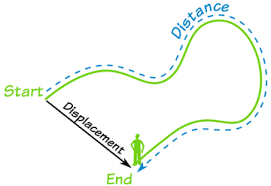Motion and its type
Introduction to Motion
When we talk about motion or rest it is with reference to some point known as the origin.
So, now with respect to the change in the position we have two quantities which can be used to describe that change in position.
They are distance and displacement. So now the question is, what is the difference between the two?
Talking about distance, it is defined as the total path length covered during the motion. It can be represented only by magnitude. On the other hand, displacement is the shortest distance between the initial and final position. It requires both magnitude and direction for complete representation.
What is Motion?
We can define motion as the change of position of an object with respect to time.
A book falling off a table, water flowing from the tap, rattling windows, etc all exhibit motion. Even the air that we breathe exhibits motion! Everything in the universe moves. We live in a universe that is in continual motion.
Motion is mainly described in terms of the following terms:
Distance
Displacement
Speed
Time
distance and displacement are used to describe the change in position.
DISTANCE-- distance between A and B is, we can’t give a definite answer because it depends on the path taken. It may or may not be the same for all three paths.
DISPLACEMENT-- displacement is a straight line joining the two points.
In other words, displacement is nothing but the shortest distance between the two points, which in this c
Distance travelled = Total path length covered
So for a motion,
distance always be greater than or equal to displacement.
Types Of Motion
According to the nature of the movement, motion is classified into three types as follows:
1.Linear Motion
2.Rotary Motion
3.Oscillatory Motion
Linear Motion
In linear motion, the particles move from one point to another in either a straight line or a curved path.
The linear motion depending on the path of motion is further divided as follows
Rectilinear Motion – The path of the motion is a straight line.
Curvilinear Motion – The path of the motion is curved.
A few examples of linear motion are the motion of the train, football, the motion of a car on the road, etc.
Rotatory Motion
Rotatory motion is the motion that occurs when a body rotates on its own axis.
A few examples of the rotatory motion are as follows:
Eg-- The motion of the earth
the motion of wheels
Oscillatory Motion
Oscillatory motion is the motion of a body about its mean position.
Eg--
When a child on a swing is pushed, the swing moves to and fro about its mean position.
The pendulum of a clock exhibits oscillatory motion as it moves to and fro about its mean position.
The string of the guitar when strummed moves to and fro by its mean position resulting in an oscillatory motion.
Examples Of Motion
Now let us understand motion clearly with the help of a few examples
Our daily activities like walking, running, closing the door, etc. involve motion. There is a change of position of the object involved in these activities.
The flow of air in and out of our lungs is also an example of motion.
The automobiles that carry passengers from the place of pick up to the destination possess motion. In this case, the position of passengers is changed from one place to another.





Comments
Post a Comment